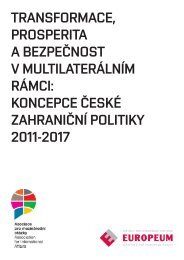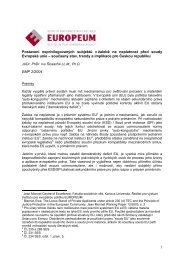eu constitutionalisation - EUROPEUM Institute for European Policy
eu constitutionalisation - EUROPEUM Institute for European Policy
eu constitutionalisation - EUROPEUM Institute for European Policy
You also want an ePaper? Increase the reach of your titles
YUMPU automatically turns print PDFs into web optimized ePapers that Google loves.
Chapter 5: The <strong>European</strong> Constitution and the Re<strong>for</strong>m of External Competencesand the extended powers under the common commercial policy, theadditional recognition of concurrent implied competences in Art. III-323CT would almost seem excessive.³⁴c. …or insofar as its conclusion may affect common rules or alter their scopeIn its last element, the CT takes up the “original” AETR-doctrine, without,however, taking account of the Court’s rulings in the specific cases,where an area “is already largely covered by such rules” (Opinion 2/91, paras25 and 26) or “where the Community has achieved complete harmonisation ina given area”. As Cremona observes, also the phrase: “The Union shall haveexclusive competence <strong>for</strong> the conclusion of an international agreement[…] when its conclusion affects an internal Union act” is misleading. Sheemphasises that it is not the conclusion of the agreement by the Communitywhich might or might not affect an internal act but that the conclusion ofa particular agreement by one or more member states acting alone mightaffect those rules or alter their scope”.³⁵ However, it is argued that thesepoints may be interpreted in the light of the Community acquis, particularlywith regard to the Court’s finding that in the case of common rules largelycovering an area, “member states may not enter into international commitmentsoutside the framework of the Community institutions, even if there is no contradictionbetween those commitments and the common rules”.It is also with regard to this last element that finally the provisions of Art.I-13 and Art. III-323 CT coincide to the largest extent. This, at least, may beinterpreted as a strong indication that the two provisions were intendedto produce the same legal effects, namely to confer exclusive externalcompetence to the Union.However, in an overall view an explicit statement seems hardly possible tomake and, at least, in this regard the CT has accurately continued the line ofthe ECJ’s jurisprudence: it has avoided a clear statement on the existence of34) Compare GRILLER (2004), p. 41 referring to the provisions in the CT conferring (explicit) shared externalcompetences to the Union, as <strong>for</strong> example, environment (Art. III-233 para 4 CT), research, technologicaldevelopment and space (Art. III-248 CT), readmission agreements with third countries (Art. III-267 para 3 CT),development cooperation (Art. III-316 para 2 CT), economic, financial and technical cooperation with thirdcountries (Art. III-319 para 3 CT) and humanitarian aid (Art. III-321 para 4 CT) as well as the ECJ’s judgment onthe EU-US Energy Star Agreement (C-281/01, Commission vs Council (Energy Star-Agreement), ECR 2002/I-12049), according to which the scope of the CCP may also extend to other areas, such as the environment,agricultural policy or the internal market in general that normally require specific legal bases.35) CREMONA (2003), p. 1362 with reference to Opinion 2/91, para 9.160Chapter 5: The <strong>European</strong> Constitution and the Re<strong>for</strong>m of External Competencesimplied shared (concurrent) competences and left the question as a matterof dispute to academia. But even if it were assumed that this competencecategory would be abolished in the CT (to the extent that it presentlyexists), the external powers conferred upon the Union by Art. I-13 CT andIII-323 CT are in any event comprehensive. Particularly the conferral ofpowers through a legislative (or binding) Union act, might create considerabledynamics <strong>for</strong> the Union to act in the international sphere.V. THE UNION’S EXTERNAL ACTION:INDIVIDUAL COMPETENCE PROVISIONSV.1. IntroductionThe following chapter contains an overview on the individual competenceprovisions governing the Union’s external relations in Title V ofthe constitutional treaty. Title V is divided into eight chapters. Chapter I,which includes the general provisions, has already been dealt with in theprevious Section. The implications of these provisions on the individualfields of the Union’s external action will, however, be considered in therelevant context.V.2. Chapter II: The Common Foreignand Security <strong>Policy</strong> (Art. III-294 – III-313)V.2.1. General ObservationsDespite the merging of the pillars, the introduction of a single legal personalityand the integration of the CFSP and CSDP under the general umbrellaof “Union external action”, the CT highlights in several ways that the CFSPmaintains its specific status. Ultimately, one may state that, despite the outwardlyuni<strong>for</strong>m structure, the pillar structure re-enters through the backdoor.The separate competence category <strong>for</strong> the CFSP in Part I CT (Art I-12 para 4and I-16 CT) provides a first indication. It displays the reluctance to applyeither of the legal consequences attached to the categories of shared competencesor the area of supporting, coordinating or complementary action161








